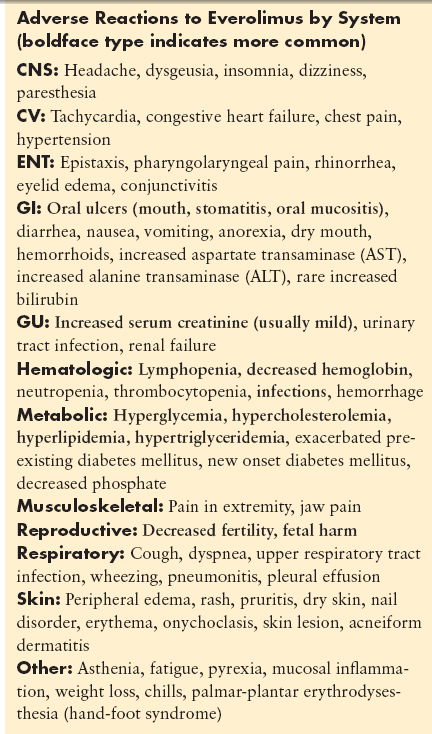New mTOR* Inhibitor for Renal Cell Cancer
Once-daily oral inhibitor of mTOR (mammalian target of rapamycin) for the treatment of patients with advanced renal cell carcinoma (RCC) after failure of treatment with sunitinib (Sutent) or sorafenib (Nexavar).

Gail M. Wilkes, MS, RNC, AOCN, is an oncology educator and nurse practitioner at Boston Medical Center, Boston, Massachusetts. She has published cancer-related books for patients and professionals, and is an author of the Oncology Nursing Drug Handbook.
Approved Drug: Everolimus (Afinitor) Indications
Once-daily oral inhibitor of mTOR (mammalian target of rapamycin) for the treatment of patients with advanced renal cell carcinoma (RCC) after failure of treatment with sunitinib (Sutent) or sorafenib (Nexavar).
Mechanism of Action
The mammalian target of rapamycin, mTOR, is a serine-threonine kinase, which acts like a master switch between catabolic and anabolic metabolism,[1] and, as such, influences cell proliferation, angiogenesis, and glucose uptake. This pathway is dysregulated in a number of solid tumors, including renal cell cancer. Everolimus is a kinase inhibitor that blocks mTOR, and thus it decreases tumor cell proliferation, angiogenesis, and glucose uptake.
Metabolism
Peak serum drug levels are reached in 1 to 2 hours after once-daily oral dosing, with steady state achieved within 2 weeks. Taking the drug with a high-fat meal reduces the area under the curve (AUC, the bioavailability of the drug in the serum) by 16%, and reduces the peak serum concentration by 60%. The drug is 74% bound to plasma proteins in both normal patients and those with moderate hepatic impairment. Everolimus is a substrate of the CYP3A4 hepatic microenzyme system, as well as a substrate for the multidrug efflux pump P-glycoprotein (Pgp) in cells. While everolimus is a competitive inhibitor of the metabolism of CYP3A4 and YP2D6, at a dose of 10 mg daily it is thought to be too low to affect the metabolism of VYP3A4 or CYP2D6 substrates. Patients with moderate hepatic dysfunction had twice the drug serum concentration, so the dose should be reduced in these patients. The mean elimination half-life of everolimus is about 30 hours, and the drug is largely excreted in the feces, with only about 5% excreted in the urine. The drug appears to be cleared more slowly with higher serum levels in a small sample of Japanese patients, and oral drug clearance was higher (20%) in black compared with Caucasian patients. The drug crosses the placenta and results in reduced female and male fertility; however, the drug is not mutagenic or carcinogenic in testing.[2]
Drug Administration
• Drug is indicated for the second-line treatment of patients with advanced renal cell cancer after treatment failure with sunitinib or sorafenib.
• Drug is available in 5-mg and 10-mg tablets in blister packs.
• Take one 10-mg tablet daily with a full glass of water, with or without meals.
• Dose reduce to 5-mg tablet daily if there is moderate hepatic dysfunction.
Patient Education
• Before starting everolimus, physician must be notified if patient is taking St. John’s wort, antifungal or antibacterial medications, or immunosuppressants, or is being treated for tuberculosis, seizures, HIV/AIDS, or cardiovascular disease. Patient must also inform the physician if he or she currently has or has a history of hepatic impairment, diabetes, or hypercholesterolemia.
• Patient must remember to take the everolimus tablet at about the same time every day, or to skip the dose for that day if late by 6 hours or more, and resume the next day at the usual time. Remind patient NOT to take a double dose to compensate for the missed dose.
• Patient should not crush or chew the tablet, or eat grapefruit or drink grapefruit juice during treatment with everolimus.
• Remind patient to keep the drug in its original packaging, and to use scissors to open the blister pack just before taking the pill. Also make clear that the package must be kept dry, out of direct light, and away from children or pets.
• Tell patient to be sure to keep appointments for blood tests throughout therapy so that impact of drug on cells, blood glucose, and renal and hepatic function can be monitored.
• atient must be instructed to contact physician immediately if experiencing any breathing problems. Patient may need to discontinue the drug for a while or the dose may need to be reduced.
• Patient must contact physician immediately if he or she is experiencing a fever of 100.5° F or higher, has chills, or is not feeling well. Pneumonia or another bacterial or fungal infection may develop, and can be fatal.
• Everolimus can depress the immune system. Patient may not receive live vaccinations or immunizations, or be around others who have recently received a live vaccine such as intranasal influenza, measles, mumps, rubella, oral polio, tuberculosis (BCG), yellow fever, varicella, and Ty21a typhoid vaccines.
• Fatigue will occur. Teach patient self-care strategies to minimize fatigue and remind him or her not to operate any dangerous tools or machinery when fatigued.
• Patient must be informed that this drug may cause damage to the unborn fetus, and that it is imperative that she tell the physician if she is pregnant or could become pregnant. Both men and women must use effective birth control measures during treatment and for 3 months after cessation of therapy. If pregnancy occurs, physician must be contacted as soon as possible.
• Teach patient that mothers should not nurse their infants while receiving everolimus, as it is unknown if the drug is in breast milk.
Drug Interactions
• Strong or moderate inhibitors of CYP3A4 and PgP inhibitors may increase everolimus blood concentrations and should not be given with everolimus: ketoconazole, itraconazole, clarithromycin, atazanavir, nefazodone, saquinavir, telithromycin, ritonavir, amprenavir, indinavir, nelfinavir, delavirdine, fosamprenavir, voriconazole, aprepitant, erythromycin, fluconazole, grapefruit juice, verapamil, diltiazem.
• CYP3A4 inducers may decrease everolimus blood concentrations and should not be given with everolimus: dexamethasone, phenytoin, carbamazepine, rifampin, rifabutin, phenobarbital; if drug must be coadministered, consider increasing everolimus dose to 20 mg daily in 5-mg increments, with the dose restored to 10 mg once the inducer drug is stopped.

Special Considerations
• Drug should be used with caution in patients with mild hepatic impairment (Child-Pugh class B), and the daily dose reduced to 5 mg; drug is contraindicated in patients with Child-Pugh class C hepatic impairment.[3] Child-Pugh hepatic impairment is calculated by adding up points for each of five clinical measures of liver disease: bilirubin, serum albumin, international normalized ratio, ascites, hepatic encephalopathy.
• Drug may cause noninfectious pneumonitis, which has been fatal in some patients; monitor for clinical signs and/or symptoms closely, and manage by dose reduction, drug cessation, and/or corticosteroids.
• Drug increases risk of infections, so patients should be monitored closely and treated promptly.
• Oral ulceration common: teach patient self-assessment, systematic oral cleansing, and topical treatments if needed. (Patient should not use antifungal medications until after this has been diagnosed.)
• The following blood work should be performed at baseline and periodically during treatment: serum creatinine, BUN, fasting glucose, lipid profile, CBC/platelets, hepatic function tests. If possible, glucose and lipid control should be established prior to beginning everolimus.
Contraindications/Precautions
• Patients with a known hypersensitivity to everolimus, to other rapamycin derivatives, or to any substances used in its manufacture should not use everolimus.
• Drug should not be administered to patients with severe hepatic impairment (Child-Pugh class C).
References:
1. Faivre S, Kroemer G, Raymond E: Current development of mTOR inhibitors as anticancer agents. Nat Rev Drug Discov 5(8):671â688, 2006.
2. Novartis Pharmaceuticals Corporation. Afinitor Package Insert. East Hanover, NJ, March 2009.
3. Pugh RN, Murray-Lyon IM, Dawson JL, et al: Transection of the oesophagus for bleeding oesophageal varices. Br J Surg 60(8):646â649, 1973.